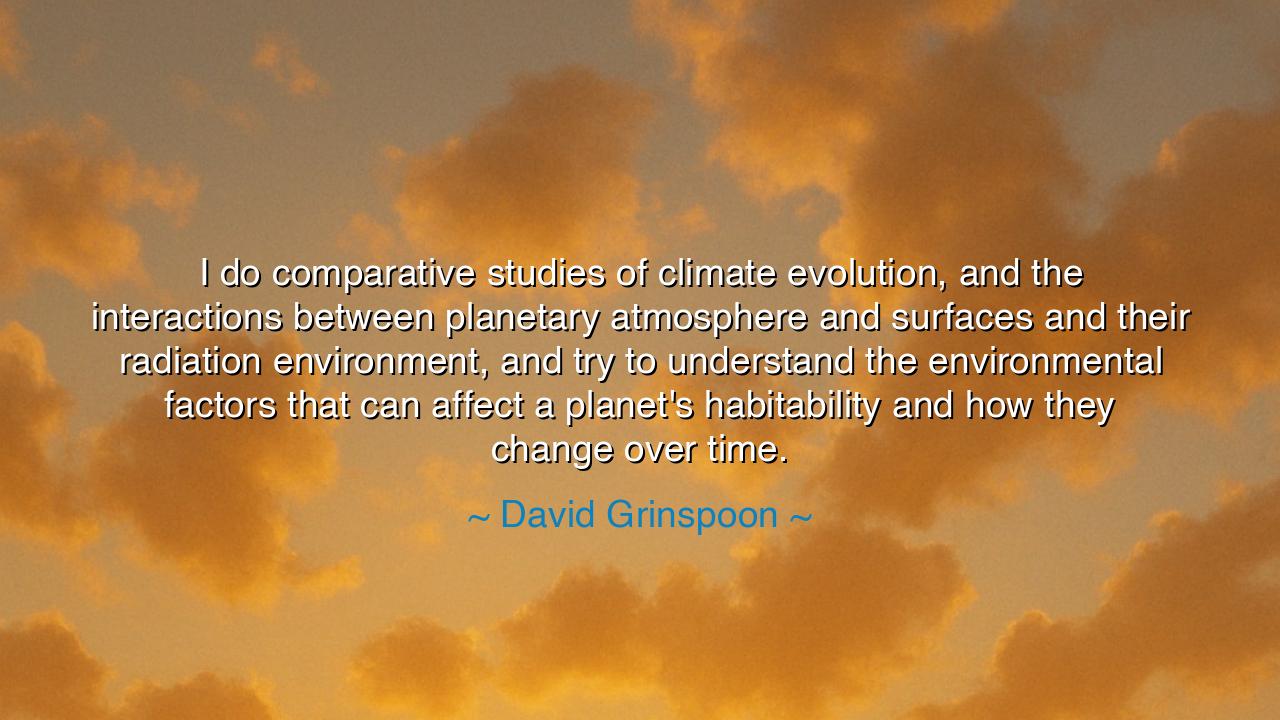
I do comparative studies of climate evolution, and the
I do comparative studies of climate evolution, and the interactions between planetary atmosphere and surfaces and their radiation environment, and try to understand the environmental factors that can affect a planet's habitability and how they change over time.






The words of David Grinspoon, scientist and interpreter of the heavens, are not spoken lightly: “I do comparative studies of climate evolution, and the interactions between planetary atmosphere and surfaces and their radiation environment, and try to understand the environmental factors that can affect a planet's habitability and how they change over time.” In these words, he reminds us that the story of the Earth is not written alone. Our world is one among many, and by studying the fates of other planets, we may see with greater clarity the destiny that awaits us if we do not tread with wisdom.
At the heart of his words is the art of comparison. For to understand the Earth, Grinspoon does not look only downward, but outward—toward Venus, where runaway greenhouse gases have scorched the surface into a furnace, and toward Mars, where thin air and cold deserts remind us of what happens when an atmosphere is lost. These worlds are like mirrors, each one a lesson inscribed in rock and sky, showing what can become of a planet when balance is broken. By studying them, he seeks to grasp the forces that shape habitability, the fragile thread upon which life depends.
History too has its echoes of such wisdom. When sailors of the ancient world ventured beyond the sight of their homeland, they studied the winds, the stars, and the seas, comparing one voyage with another, so that no storm might catch them unawares. Just as navigators once charted the oceans, Grinspoon charts the seas of climate and radiation, seeking the hidden patterns that govern whether a world may sustain life. His work is the new cartography of the cosmos, mapping not coastlines but atmospheres, not harbors but the thin boundaries between life and lifelessness.
His words remind us that habitability is not eternal—it is dynamic, shifting with time. Planets are born, they evolve, they endure catastrophes and transformations. So too with Earth: ice ages have come and gone, atmospheres have changed, life itself has altered the composition of the air. By recognizing these changes across the ages, Grinspoon warns us that human activity now accelerates these shifts, pushing the Earth into dangerous territory. To see this truth clearly, he looks to the histories of other planets, where the results of imbalance are writ large.
The origin of such studies lies in the merging of astronomy and environmental science. Where once the stars were seen only as distant lights, we now see them as suns with worlds of their own, each one a laboratory of fate. Grinspoon’s work is born from this new vision: to use the lessons of the cosmos to awaken humanity to the precariousness of its own condition. He stands in a lineage of prophets—not of temples, but of telescopes—calling us to humility before the vastness of creation.
The lesson is clear: to safeguard the Earth, we must not only look inward but also outward. For in Venus’s furnace we see the danger of unbridled warming; in Mars’s barrenness we see the peril of a dying atmosphere. Our world is not exempt from such fates—it stands at the crossroads, and the choices of humankind will determine which path it takes.
Therefore, children of tomorrow, take David Grinspoon’s wisdom to heart. Study the stars, but let their lessons guide your stewardship of the Earth. Do not assume that the cradle of life is invincible; cherish its balance, guard its air and waters, and walk lightly upon its soil. For habitability is a gift, not a guarantee. And only by learning from the fates of other worlds can we preserve the one world that is, for now, our only home.






AAdministratorAdministrator
Welcome, honored guests. Please leave a comment, we will respond soon